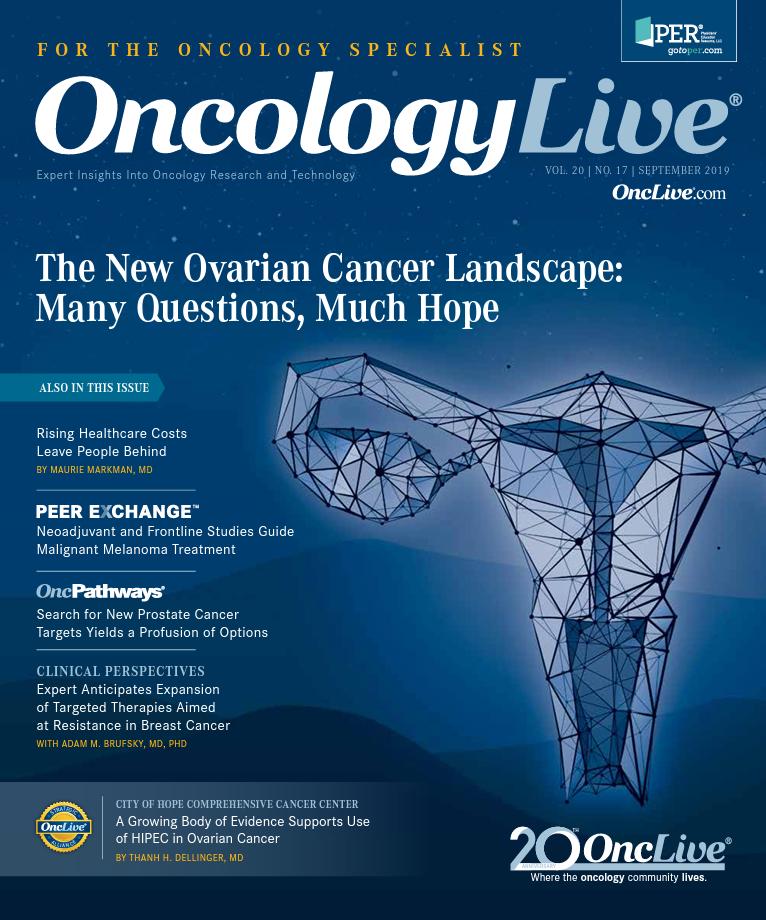Expert Anticipates Expansion of Targeted Therapies Aimed at Resistance in Breast Cancer
New strategies to address resistance in patients with estrogen receptor–positive breast cancer are in the works, thanks to a greater understanding of the cell-signaling networks activated during the course of disease.
Adam M. Brufsky, MD, PhD, medical director of the MageeWomen's Cancer Program at the University of Pittsburgh Medical Center Hillman Cancer Center

Adam M. Brufsky, MD, PhD
Many new strategies to address resistance in patients with estrogen receptor (ER)—positive breast cancer are in the works, thanks to a greater understanding of the cell-signaling networks activated during the course of disease and treatment, according to Adam M. Brufsky, MD, PhD. He expects many targeted agents, particularly in the adjuvant setting, to become available as clinical investigations mature.
Brufsky, medical director of the MageeWomen’s Cancer Program at the University of Pittsburgh Medical Center (UPMC) Hillman Cancer Center in Pennsylvania, is a leading breast cancer investigator. He also is associate director of clinical investigations at UPMC Hillman and a professor of medicine at the University of Pittsburgh School of Medicine.
Brufsky spoke with OncologyLive® about the latest research in ER-positive breast cancer.
How has our understanding of the ER pathway evolved?
Let’s start at the beginning. Precursors to estrogen are converted by the aromatase enzyme peripherally into estrogen, which then binds its receptor, dimerizes, goes into the nucleus, and initiates gene transcription. That’s the simple way that we’ve thought about it for many years. We’ve developed aromatase inhibitors that block production of estrogen by inhibiting aromatase; we have tamoxifen and other SERMs [selective estrogen receptor modulators] that bind to the estrogen receptor and compete for estrogen; and then we have fulvestrant [Faslodex], which blocks the dimerization of ERs.
Our understanding has evolved over the years, and we’ve learned that there are all these other secondary pathways that arise that can cause resistance—alternative growth factor pathways that can bypass the ER pathway. Basically, these are pathways that involve extracellular signaling either through insulin-like growth factor, epidermal growth factor receptor, or the other members of the HER family of receptors. They coordinate the phosphorylation of a whole bunch of proteins in the cell, such as PI3K, which phosphorylates AKT, and all these pathways converge onto mTOR. There are pathways downstream even of that; there’s a CDK4/6 pathway that we’ve now blocked.
The first set of things that we’ve tried to do is to inhibit PI3K, and we’re doing that now with PI3K inhibitors, several of which didn’t work, but there’s now alpelisib [Piqray], which has been approved for use in later lines of metastatic, ER-positive breast cancer. Other drugs that can affect that pathway are also now in clinical testing—AKT inhibitors such as capivasertib and ipatasertib.
However, the AKT and PI3K pathways converge on the mTOR protein. mTOR is inhibited by everolimus [Afinitor], which has been used for many years in combination with exemestane or fulvestrant to block that mTOR resistance pathway. Then we have CDK4/6 inhibitors, downstream even of the mTOR pathway, such as abemaciclib [Verzenio], ribociclib [Kisqali], and palbociclib [Ibrance], that all block the transition from G1 to S phase so the cells can’t replicate. There are multiple other pathways, even more than I’ve described, but this is kind of the thinking right now in terms of ER signaling.
We’re doing a lot more DNA sequencing of patients that we didn’t do before. Forty percent of women with ER-positive metastatic breast cancer will have a PI3K [PIK3CA] mutation. We also are looking for HER2 mutations.
Where do you think that the newly approved PI3K inhibitor alpelisib will likely fit in?
I think it will be in the second, third, or fourth line after failure of a CDK4/6 inhibitor and endocrine therapy combination. It has been approved in combination with fulvestrant. I think that’s where we are going to use it initially, but it may be used with other agents, as well. But basically, it will be used pretty much beyond progression in patients who have PI3K mutations.
There are a lot of different SERMs and SERDs [selective estrogen receptor degraders] being tried out.
There are some theoretical reasons to believe that the oral SERDs may work, and I think that where they are likely to fit in, if they show equivalency to fulvestrant, is in adjuvant therapy. We’re still waiting for more solid clinical trial data.
How do you see the treatment landscape developing?
I think there are going to be a lot of these targeted agents, specifically likely in the adjuvant setting. A bunch of adjuvant studies are going on, such as monarchE [NCT03155997] and PALLAS [NCT02513394], that will tell us one way or another whether we can use these targeted therapies in the adjuvant setting.
I think there’s going to be a lot more use of DNA sequencing to help us figure out who should get PI3K inhibitors. There may or may not be some oral SERD use. There’s an antibody—drug conjugate, sacituzumab govitecan, and there’s a big trial in ER-positive disease ongoing [TROPICS-02; NCT03901339). Those are probably the big things that we’re going to see.
What are the most significant limitations in treating patients with ER-positive breast cancer?
I would say the cost of some of these therapies and the fact that it’s a little more toxic than the standard endocrine therapies. I also think that most people will develop resistance, which is a major challenge in figuring out what to do when that happens. In the past, survival benefit had been a major limitation— no therapy ever had a survival benefit; they had a PFS [progression-free survival] benefit but not an OS [overall survival] benefit. We’re just starting to see survival benefits now where we have not seen them before.




